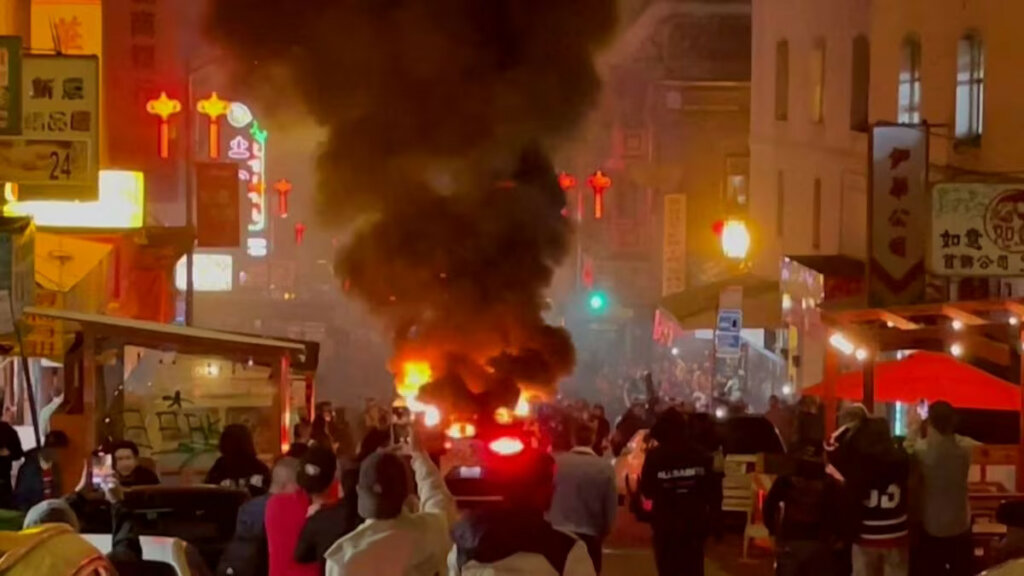Death of an innocent? Waymo robotaxi set alight

|
Getting your Trinity Audio player ready...
|
Have you seen the footage of a Waymo robotaxi going up in flames?
Waymo robotaxis have been having their moment as the sole autonomous vehicle on the roads in San Francisco. In October of last year, after an incident involving a pedestrian, Cruise – the General Motors owned self-driving offering – was accused of covering up information relating to an accident and its permit was removed by the California DMV.
That doesn’t mean Waymo, which is owned by Google, hasn’t had its own safety issues: last June, one of its vehicles killed a dog and more recently a cyclist was struck and injured having been obscured from sensors by another vehicle at an intersection.
All this is to say that the safety of driverless cars is up in the air. For many, this means they shouldn’t be on the roads; San Franciscans have understandably felt used as test subjects in the robotaxi experiment. Driverless vehicles drove more than nine million miles on public roads with test permits last year.
A recent “attack” on a Waymo robotaxi that saw the vehicle’s windows smashed before it was set alight by a firework. The cab had attempted to drive through San Francisco’s Chinatown on the first day of the lunar new year – something that a human driver would know to avoid.
Crowds brought the vehicle to a stop at the intersection between Jackson st. and Grant Avenue, where it was covered in graffiti before violence escalated.

Via Reuters.
But it’s difficult to wholeheartedly call it ‘violence’ or an attack, given that it is just a car – there were no passengers and, obviously, no driver. The Jaguar I-Pace operated by Waymo was the only ‘casualty’.
“The vehicle was not transporting any riders and no injuries have been reported,” Waymo said in a statement. “We are working closely with local safety officials to respond to the situation.”
The company previously described the vandalism as an isolated case, but another Waymo rider told Reuters he rode in a Waymo the next day through another San Francisco crowd that shot fireworks at the car.
“Once they saw the Waymo, they started pointing directly at the Waymo instead of up in the sky,” said Nathan Flurry, who recorded the scene. Flurry describes himself as a Waymo fan.
As well as the incidents involving robotaxis, some are saying that there’s a more generalized fear of AI at play.
“We are seeing people reaching a boiling point over tech that they do not want and does not make their lives better,” said Missy Cummings, director of the George Mason University Autonomy and Robotics center and a former adviser to U.S. traffic safety regulators.
Peskin, the city supervisor, said it may not have been an “anti-tech thing” but rather just criminal mischief by “a bunch of hoodlums.”
True, the streets had been almost completely clear of vehicles as pedestrians grouped to watch the fireworks. The crowd had parted for the occasional car to pass, but the Waymo robotaxi came to a halt in the middle of it all. A fire department spokesperson confirmed the Waymo vehicle partially blocked the road.
Waymo didn’t respond to questions on Monday about why the car drove into the crowded public event. The incident gives rise to another point in the driverless vehicle debate, according to Bryant Walker Smith, a professor at the University of South Carolina with expertise in autonomous-vehicle law: whether self-driving cars can or should be able to detect areas busy with pedestrians and navigate around them.
“I would be interested in hearing from Waymo about how its navigation accounts for these kinds of incidents,” he said.
Aaron Peskin, president of the San Francisco Board of Supervisors, who has called for more regulation of autonomous vehicles, said “most normal car drivers know that they have to avoid Chinatown during the Lunar New Year holidays. The computer doesn’t understand that.”
He further argued the disruption wasn’t an “anti-tech thing” but just criminal mischief by what he described as “a bunch of hoodlums.”
Although we couldn’t possibly comment on the folk in the crowd, we are inclined to agree that, although representative of festering resentments, the incident wasn’t really motivated by anti-AV rhetoric.
The Safe Street Rebels operated a campaign of disruption to driverless vehicles from their introduction to roads in 2022. Having realized a traffic cone on the hood of a driverless car interfered with sensors, halting it until a human employee ‘rescued’ it, the protestors disabled the vehicles across the city.
The Waymo incident has none of the flair or careful thinking that Safe Street Rebels have demonstrated; in their efforts to increase road safety, outright violence is off the cards.
More likely, the crowd was irritated by the interruption of a car cutting through and without a driver to exchange angry gestures with the car itself was the target of their annoyance. Then, of course, the lack of driver makes it spectacularly easy to escalate – hostility, if we can even call it that, isn’t that damaging to a vehicle the way that fireworks are.
California state Senator Dave Cortese, who is proposing legislation to give local governments more power to regulate self-driving cars, said the fact that the car drove into a crowded area during fireworks underscored the technology’s shortcomings.
“What is becoming abundantly clear is that AV technology is not as sophisticated as the industry would like us to believe.”
This after an incident in 2023 that saw a Cruise robotaxi get stuck in wet cement: “It thinks it’s a road and it ain’t, because it ain’t got a brain and it can’t tell that it’s freshly poured concrete,” resident Paul Harvey told SFGate.
The Waymo robotaxi was in the wrong place at the wrong time, poor thing, but while the incident isn’t all that different to a Boris Bike thrown into the Thames, it is a reminder of the social tensions the introduction of AVs stirs up.
Probably pleased not to be in headlines for once, GM’s Cruise has hired a new Chief Safety Officer, naming the lucky holder of the newly created role as Steve Kenner. After October’s accident, founder and CEO Kyle Vogt and COO Dan Kan both resigned, nine executives were chopped and 24% of staff were laid off from Cruise.

Steve Kenner appointed Cruise Chief Safety Officer.
That may have signalled the end, but Kenner’s new role suggests Cruise isn’t done yet. He previously served as VP of safety at self-driving truck company Kodiak and before that was Chief Product and Safety Officer at another driverless truck outfit, Locomation.
“I have worked on safety critical technologies throughout my career, I believe in the safety potential of autonomous vehicles, and I want to safely and responsibly realize that potential,” Kenner said in a statement.
General Motors hopes to relaunch services and regain Cruise’s license to operate soon – potentially the Waymo robotaxi incident will slow proceedings, a warning to the companies testing the safety of AVs in San Francisco.








